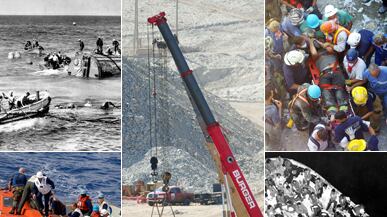—and why it's not over yet.
Two months and four days ago, one of the most talked-about mining accidents in history trapped 33 men at a depth of approximately 2,300 feet—nearly the length of two Empire State Buildings stood end-to-end.
Gallery: 7 More Amazing Rescues

Today, their rescue is imminent. On Saturday, the drill that has been working its way through the earth for almost two months finally reached the small underground space where the miners are huddled. Chilean authorities now say they might be able to start pulling the men up as soon as Tuesday.
For 17 days after the mine's collapse, no one knew if the workers had survived the accident. Then, what seemed like a miracle: Days after a probe found no sign of the miners in the place where rescuers thought they were trapped, another probe was pulled to the surface. On the drill bit, a note was written on red pencil: “ Estamos bien en el refugio los 33.” All 33 of them were alive.
But the initial rejoicing was soon tempered by a harrowing reality. The rescue of the men would take longer than any ever attempted. They have already set a world record for time trapped underground after a cave-in. Experts said they would remain trapped until Christmas—they would have to survive deep under the earth for over four months. Their families were devastated, but the men underground remained optimistic. On August 27, they were able to send up a video showing the world the conditions under which they were living. They sang the national anthem, and chanted “long live Chile.”
Not all of them were as hopeful as reports made them out to be, however. Amid the good-spirits shown on the video, 34-year-old Edison Peña can be heard mumbling the words, “Get us out of here.” Peña also sent up a letter for his wife, in which he begged her to get more information. “Angélica, what have they told you about us? Have they installed any rescue machinery, or are they at least installing it? What’s the timeframe? Have they given you a possible date for when they’ll get us out of here? I hear it might be two months; is that true? Please, find out.”
Every 48 hours, each man consumed two spoonfuls of tuna, a piece of peach, a little bit of milk, and a bite of crackers.
From the beginning, the miners have shown a remarkable level of unity and organization. That first couple of weeks, before any contact had been made, they survived on what was meant to be a two-day ration of food. Every 48 hours, each man consumed two spoonfuls of tuna, a piece of peach, a little bit of milk, and a bite of crackers. It paid off. When rescuers contacted them, they still had a little bit of food left. Not surprisingly, they lost weight to the point where some of their family members said they were almost unrecognizable. “My brother is so thin, and he has a mustache!” shrieked a young woman, adding, “but he still looks handsome.”
Foreman Luis Urzúa was nominated as the de facto leader of the group, organizing shifts and keeping the men in line. He has two deputies. Yonni Barrios, who learned how to give injections by caring for his diabetic mother, is in charge of medical issues, administering medication and monitoring the health of the other miners. And the oldest of the workers, 63-year-old Mario Gómez, was appointed the group's spiritual leader. He leads prayers and works to keep the men from losing hope. In the video the miners recorded in late August, Gómez is heard saying, “This is for my wife, for my children and for my grandchildren.”
The miners' discipline and organization has been crucial to the rescue effort. The tunnels being built for their rescue produce an estimated half-ton of rock debris per hour, which the trapped miners must work 24 hours a day to clear. Timed halogen lights, which were lowered into the mine to help mimic daytime and nighttime, have helped them maintain as normal a routine as possible. Meanwhile, three separate rescue attempts have been proceeding simultaneously: One conducted with the help of NASA, the others spearheaded by two Pennsylvania drilling companies, Center Rock, Inc., and Schramm, Inc. It is the tunnel being built by Schramm which has now reached the miners.
At the surface, the man who has emerged as the rescue attempt's figurehead is Laurence Golborne, the Chilean Minister of Mining. The crisis has made Golborne a household name—and one of Chile’s most popular politicians. He now has over 50,000 followers on Twitter, and several Facebook groups have popped up, calling him the “best minister” in the country, and even encouraging him to run for president in 2014. Yet in his first interview since the accident, published today by El Mercurio, he affirms that he does not see himself as a hero, and that, if anything, it is the miners who have taught him a lesson in strength and discipline.
Golborne sent the media into a frenzy on Friday morning with a tweet quoting a popular song with the lyrics, “Today might be a great day, think about it that way.” Later, in a press conference, he explained that the tunnel had almost reached the miners, and the steps that will now follow. The first decision engineers have to make is whether or not to line the entire rescue tunnel with steel pipes. They believe the bottom third might not need this lining, but they are wary of taking too many chances. Once this has been determined, a capsule will be sent down, and the miners will be pulled up one by one.
• Dom Phillips: The Miners' Miracle MessageThe news that the rescue is imminent brought some family members to tears. But even as the proverbial light at the end of the tunnel begins to shine, experts warn against celebrating prematurely. Whether the tunnel is lined or not, the fit will be very tight. As John E. Urosek, chief of mine emergency operations for the United States Mine Safety and Health Administration explained to The New York Times, “There’s only about two inches clearance around it, and they’ll have to pull it out of that depth so many times, it could get wedged.” Then there’s the blasting that the miners themselves will be required to do—explosives will be sent down, which the men will have to set off in order to widen the tunnel on their end.
For now, the day everyone is waiting for is October 12—the 518th anniversary of Christopher Columbus’ arrival in the New World. On that day, if all goes well, the 33 men will emerge from the ground. Columbus and his crew spent 70 days at sea. Foreman Urzúa and his men will have spent 68 days underground. They were mining for gold, the very treasure that inspired the Spanish to explore what is now known as Chile.
Constantino Diaz-Duran has written for the New York Post, the Washington Blade, and the Orange County Register. He lives in Manhattan and is an avid Yankees fan. You'll find him on Twitter as @cddNY.






